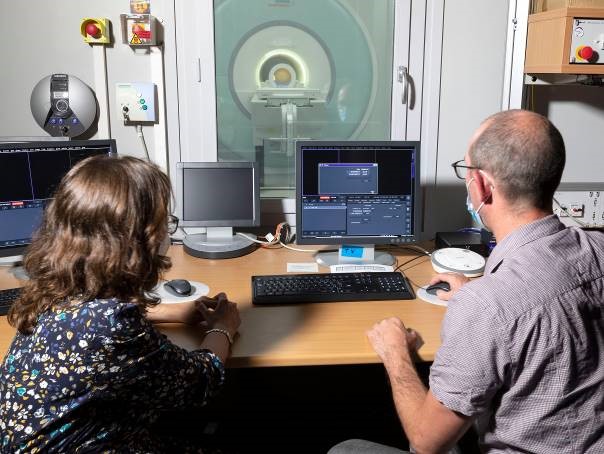The commissioning of the 11.7 T Iseult MRI in 2021 crowned almost 20 years of AOC research and development. In an article published in the journal Magnetic Resonance Materials in Physics, Biology and Medicine, Nicolas Boulant and Lionel Quettier, Iseult project leaders for the CEA's Joliot and Irfu Institutes, review the details of this commissioning.
From the project to build a research center entirely dedicated to brain imaging (Neurospin) that would house the world's only MRI scanner with a magnetic field of 11.7 T, to the first images obtained with this MRI in 2021,, the “Iseult” soap opera has held the community of magnetic resonance imaging specialists on the edge of their seats for more than 20 years... and the adventure is not over.

Right: the MRI with its equipment (credit: Francis Rhodes)
In their article, Nicolas Boureux and Lionel Quettier review the last steps of tests and validations that were necessary before this exceptional MRI scanner could be put into operation.
The interactions between the different components of 11.7 T MRI were uncharted territory and were progressively investigated. With the constant concern to minimize the risks concerning the magnet itself, these last steps were also the opportunity to accumulate as much information as possible on the overall behavior of the system, which could affect the quality of the images.
Acoustic measurements, vibration measurements, power deposition in the helium bath and dynamic tracing of the field generated by the gradient coils were all scrutinised over several months. The impact of the imaging equipment (gradient coil, antennas, etc.) on the safety system of the main magnet was tested and the system was calibrated to define the correct operation of the gradient coil. The first measurements using parallel transmission were also carried out on the ex-vivo brain to overcome the effects of inhomogeneity of the radiofrequency field.
The scanner is now operational. A first data collection campaign on healthy volunteers will take place this year to evaluate the effects of static magnetic fields and the benefits of MRI with very high magnetic fields for brain research and to obtain ANSM’s final authorization to start scientific studies.
Contacts: Lionel Quettier (Irfu), Nicolas Boulant (Joliot)
Reference: https://doi.org/10.1007/s10334-023-01063-5
Other hightlights of the project: ISEULT (cea.fr)
• Innovation for detection systems › Achievements in response to societal challenges superconducting magnet physics and technology › Instrumentation and development for R&D magnets Accelerator physics and technology
• Accelerators, Cryogenics and Magnetism Division (DACM) • The Systems Engineering Division
• ISEULT




